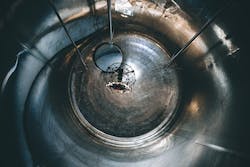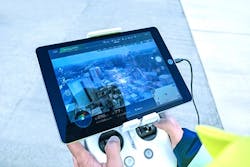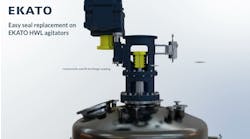Drones can carry out incredibly detailed inspection work with potentially huge safety and economic benefits, as the experiences of Flyability, Chevron and Thyssenkrupp show. At the same time, makers of sensors and manufacturers of drones — also known as unmanned aerial vehicles (UAVs) — are working to deliver the next generation of technologies demanded by an increasingly enthusiastic chemical industry.
Formed in 2015, Flyability, Paudex, Switzerland, has sold more than 1,000 of its Elios drones to over 450 customers. The UAVs handle critical infrastructure inspection for chemical, oil and gas and power generation facilities (both fossil fueled and nuclear).
Its latest version, Elios 2, is an intuitive-to-fly drone fitted with an RGB camera, a powerful lighting system, and sensors used in aircraft stabilization. It is designed to perform reliably in environments not suitable for use of a global positioning system, in dark, dusty and troubled airflows, beyond line of sight and, particularly, in places that no other drone can access.
“Preventing human exposure to dangerous situations like confined spaces entry [Figure 1] and work at height is definitely the most compelling benefit of using drone technology,” says Marc Gandillon, Flyability’s head of marketing.
At the same time, the overall savings achieved from reduced downtime, lower operation costs, and increased quality and quantity of data are enormous, he stresses. Most users recover their initial investment within a year, some within one flight. One customer saved $500,000 with a single inspection, he notes.
“Adopting drone technology has a non-negligible implementation cost. This includes equipment acquisition and maintenance, user training, and any changes that have to be made to the inspection process itself to allow for the use of new equipment/technology. However, having drone technology in your asset maintenance operations is a mindset. You know you’ll save someone’s life down the road and, with the proper involvement in your drone program, you will improve your figures,” Gandillon adds.
Right now, the primary attraction of Elios 2 is its visual data that allow users to remotely assess the inner condition of assets to spot cracks, pitting or other anomalies, he notes. However, the company constantly receives requests to integrate other monitoring devices such as ultrasonic thickness, radiation and even gas sensors. “A lot of people would like to be able to map their assets using a LiDar (laser imaging, detection and ranging) sensor. These are all tracks for our technology to evolve along,” he says.
Refinery Results
One company that has been involved with Flyability since 2015 is Chevron. The most recent maintenance program using Elios 2 took place in April at its El Segundo refinery, El Segundo, Calif.
“Four main benefits are associated with using UAVs/drones: increased safety margins; reduced risk; improved efficiency — getting more work done in less time, with fewer people, and saving money; and delivering high quality data more quickly — typically within minutes of completion,” notes Larry Barnard, downstream & chemicals, manufacturing, unmanned aerial systems governance at the refinery.
He points to many quantified benefits. For example, the El Segundo facility has over 800 company-owned power poles that require inspection every two years. Pre-UAV, this task would involve three boom trucks with buckets, five contractors and cost more than $1,000/pole — typically with only three poles inspected per day. Now, one small UAV with a 20-megapixel camera and one operator can inspect 20 poles/hr. “So, we’ve reduced the risk of working at heights and in close proximity to dangerous conditions. Also, the UAV provides a high resolution ‘record’ of the asset that can be stored/saved/compared over time,” he adds.
Figure 1. Besides keeping people out of harm’s way, using a drone generally offers a fast payback on the initial investment. Source: Flyability.
Similarly, pre-UAV vessel inspections typically needed 2–3 days on a turnaround schedule with scaffolding time and costs playing a big part. Now, inspection of the entire vessel only takes a few hours, without any of the confined space entry requirements such as rescue equipment, hole watch, communications and permitting. “Again, we get very good data that can be archived, attached, referenced and compared over time,” says Barnard.
In addition, during the turnround at El Segundo, one of Chevron’s Elios-2-trained process engineers operated the drone inside three crude unit furnaces to inspect refractory and furnace tube integrity.
“We were able to inspect the fin tubes in the convection section to determine whether or not carbon dioxide blasting was needed to clean them and restore their efficiency. The drone data helped determine that we could forego the cleaning at this outage — a very significant saving,” stresses Barnard.
It’s important to understand that “inspections” take many forms, he explains. “Process engineers were very interested in performing inspections related to ‘operability and conditions’ of components that affect operability of equipment and process envelopes. This is a very interesting perspective and completely disassociated from a ‘compliance type’ regulatory agency inspection re: integrity of equipment and protection of environment and surrounding community.”
Process engineers make ideal UAV operators, Barnard feels. To ensure their skills remain sharp, he advises having a qualified subject matter expert institute training policies and develop documentation.
However, he cautions, there’s still a significant way to go to remove the stigmas and concerns associated with drones. “They vary widely but are typically related to training, regulatory requirements, skills to safely use and maintain the equipment, and, of course, what to do with all the data they generate.”
Looking to the future, he believes UAV autonomy is key — but hurdles remain. For example, few UAVs on the market are capable of self-launching, on a scheduled frequency, and remotely from one or more fixed locations. Even fewer have the onboard computer vision and artificial intelligence (AI) needed to detect and report anomalies. In addition, regulatory agencies have a very onerous waiver/safety case process for approving drones that are flying beyond the visual line of sight. “So they do not allow UAVs without waivers, test data, proof of capability and, in some cases, vehicle certification. They are treated as one-offs and the agencies involved are not yet set up to manage a large number of requests,” he notes.
Even so, Barnard believes these hurdles will be overcome, and, within the next five years, UAVs could be launched on pre-configured missions and be able to detect anomalies along the flight path on their own — with pilots perhaps becoming a thing of the past.
“It’s entirely feasible to expect this level of autonomy on commercially available UAVs within five years using a combination of enabled aircraft in small, fixed housing locations enabled with edge/computer vision sensors, performant network connectivity, and data analytics platforms managing the AI and broadcast to the ‘user/customer.’”
He envisages a time in the near future when Chevron’s drones are taking off from multiple locations simultaneously and, within 30 minutes of landing, sending him an email identifying a potential issue, or texting him saying: “No anomalies found, next scheduled flight is tomorrow at 4 pm.”
Figure 2. Hand-held unit can control drones sent out to detect issues and inspect equipment. Source: Thyssenkrupp.
Ongoing Evolution
“Drones will get more and more automated and equipped with visual positioning and collision avoidance systems, for example the Skydio 2 drone,” reckons Philipp Esser, digital device product manager at Thyssenkrupp, Essen, Germany. “This way, it will be possible to program different inspection missions into drones. In combination with automated data analysis, this then allows a continuous monitoring of industrial plants. When collecting data continuously over a long period of time, advanced data analytics models can learn to predict failures and problems that slowly develop over time, which would not be possible with single, manual inspections.”
Thyssenkrupp uses commercially available drones. The Skydio 2 drone cited is manufactured by Skydio, Redwood City, Calif., and combines a proprietary AI system with a 4K60-high-dynamic-range camera, a 3.5-km wireless range and 23 minutes of flight time. A mobile phone, beacon or hand-held unit (Figure 2) can control the drone.
Thyssenkrupp developed its original drone skills on company cement plants, mines and coke plants. While strict regulations prohibited drone use at operating chemical plants, they did serve as useful inspection tools during shutdowns, he notes.
Today, its customizable drones easily can create 3D scans or maps of buildings — and so are a very helpful tool for documentation of building processes such as new build projects. The same 3D data also ease carrying out reengineering of certain parts of a plant during revamps.
Nevertheless, inspections remain the major use of drone technologies. “Many of our customers’ plants have a high thermal footprint, so we focus on thermal inspections with drones. Using drones for the inspection of bigger areas is usually quicker and safer and allows customers to get an overview of a situation from a distance, which is often not possible when walking around walkways inspecting equipment manually,” he says.
Typical uses include for detecting a variety of issues, e.g., deformation (through 3D measurement), hot spots or failed insulation material, pipe congestion, and cracks or corrosion. Other common chores are estimating general heat loss and inspecting confined and indoor areas that pose health hazards to inspection staff.
“Depending on the case, we use different platforms. So, when talking about inspections, there are several ways to do it, ranging from a rather manual approach to a fully automated approach,” Esser explains.
For example, during manual inspections, a customer’s own experts at a site can check the live video feed from the drone. (Some of these experts have been trained to fly drones by Thyssenkrupp pilots.) Another option is to upload images to the cloud. This gives inspection staff the opportunity to analyze them and create reports from the data recorded.
Thyssenkrupp also has developed machine learning algorithms that can automatically analyze the pictures to detect critical conditions, cracks or other problems. “This way, we can filter a huge dataset and even present the critical problems on a map or 3D model of the plant. So, it is easier to, for example, localize the cause of a problem,” he adds.
“What differentiates us from other drone service providers is that we have deep knowledge of the plants we are using the drones in. This makes it easier for us to find the relevant use cases and to (manually or automatically) analyze the recorded data. Most drone service providers only deliver the pictures without a report on the findings,” explains Esser.
For process engineers unused to or unsure about drone use, Esser suggests booking a service that includes different inspection scenarios. “If the inspection delivers value, I would recommend to invest in drone technology and train a few people on site. This way inspections can quickly be done, regularly, without the need to book external pilots.”
That way, the process engineers themselves can analyze the data, with support from Thyssenkrupp experts, or the company’s data analytics algorithms.
Dual-Sensor Module
One example of an advance in drone technology occurred in July when thermal-imaging infrared camera specialist FLIR systems, Wilsonville, Ore., launched Hadron. The company claims the unit is the first dual-sensor module suitable for drones. It includes a 12-megapixel visible camera paired with the company’s Boson 320×240 resolution thermal camera with up to a 60-Hz frame rate.
The launch followed close collaboration with drone manufacturers Vantage Robotics, San Leandro, Calif., and Teal Drones, Salt Lake City, Utah, to perfect the module for use on lightweight drone airframes.
Vantage Robotics has integrated Hadron into its microgimbal platform. It features proprietary stabilization technology as well as the dual sensor and can be fitted to existing UAV airframes and potentially other robotic platforms.
“Hadron is far and away the lightest and smallest combined visible-thermal sensor that has ever been commercially available,” says Tobin Fisher, Vantage Robotics ceo. “For an aircraft where you’re trying to push the limit on flight performance, every gram matters. The ability to get these sensor capabilities in a package this small makes an enormous difference,” he adds.
Teal has integrated Hadron within its 1-kg Golden Eagle UAV platform. Taking advantage of the module’s compact size to create a lightweight yet dynamic payload helps preserve battery life and maximize flight time on a small airframe, notes the firm.
“Hadron enables us to speed development and time-to-market for small airframes with thermal and visual sensors,” notes George Matus, Teal Drones founder and CEO. “Its high quality, low weight and compact size allows for rapid integration to quickly develop prototypes.”
The launch comes 18 months after FLIR acquired Aeryon, Waterloo, Canada. Aeryon’s vertical takeoff and landing quad-copter airframes integrate multiple sensors, including FLIR thermal technology, to provide users with immediate high-resolution intelligence, surveillance, and reconnaissance capability — a military/industrial crossover that increasingly is driving developments in drone technology.
Seán Ottewell is Chemical Processing's editor at large. You can email him at [email protected].





